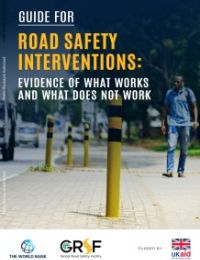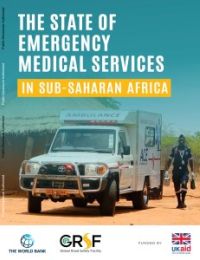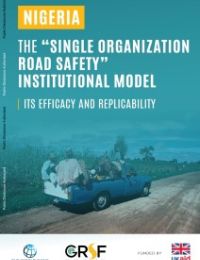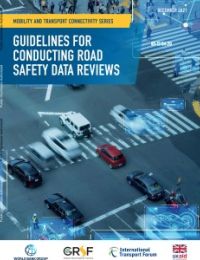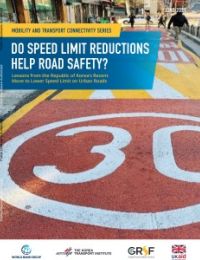Publications
21-30 of 62
-
-
-
Speed Management
Road Crash Trauma, Climate Change, Pollution and the Total Costs of Speed: Six Graphs That Tell the Story
July 2022
-
-
Road Safety Management
Nigeria: The “Single Organization Road Safety” Institutional Model, its Efficacy and Replicability
July 2022
-
What are the strengths and weaknesses of this model and what could be done to improve its’ efficiency and effectiveness?
-
How efficient and effective is the “Single Organizational Model” institutional setup (both federal and state levels) in dealing with the road safety issues in Nigeria?
-
Can this model be replicated in other LMICs and what are the factors that will determine the replicability of the model in those countries?
-
What are the steps in setting up “Single Organizational Model” institutions in LMICs?
-
-
Speed Management
Guide for Determining Readiness for Speed Cameras and Other Automated Enforcement
July 2022
-
To briefly identify the powerful practical value of AE in saving lives and reducing injuries.
-
To identify issues and criteria to be considered before commencing automated enforcement. To identify steps to be taken to achieve readiness for automated enforcement. To identify issues to improve existing automated enforcement systems.
-
To provide a checklist to ensure adequate consideration is given to issues to assess readiness to implement an AE system or improve an existing system.
- Evaluate the effectiveness of the reduced speed limits in terms of crash reduction through a before-after study.
- Examine if the speed limit change had different effects across different crash types, user types, and crash severities.
- Evaluate the impact of speed limit change on transit speed through a before-after assessment.
- Develop appropriate and actionable recommendations for departments of transportation in developing countries.
-
Road Infrastructure
Guide pour l’Intégration de la Sécurité dans la Conception des Routes (French)
July 2022
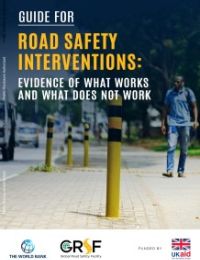
Road traffic crashes result in an estimated 1.35 million deaths and 50 million injuries worldwide per year with over 90 percent of these occurring in Low-Middle Income Countries (LMICs). Aside from the obvious pain and suffering this inflicts on individuals and communities, these deaths and injuries also place a large financial burden particularly on LMICs, by slowing economic growth.
The scale of the current response to this continuing crisis does not match the size of the problem. In addition, limited road safety resources are often expended on ineffective or suboptimal interventions. While road safety knowledge has improved over recent decades, there is still a need to improve decision making when selecting and applying effective evidence-based road safety interventions. Effective interventions are those that reduce fatal and serious injuries.
The World Bank's Global Road Safety Facility (GRSF) has developed this evidence-based guide on “What Works and What Does Not Work” in road safety in response to the critical need for effective evidence-based solutions.
This guide has been prepared to help readers understand that not all road safety interventions are equally effective and that what appear to be “common-sense” approaches to selecting road safety interventions will often not be the best. Although some provide benefits, others have very limited or even negative impacts, despite being commonly—and mistakenly—recommended or accepted. The guide offers a range of recommendations with a focus on interventions in LMICs, although the information may also be of relevance to all countries. The contents will be valuable to those working on road safety at policy or practitioner levels, including World Bank technical team leaders and others who seek to establish, expand, or improve road safety programs in LMICs.
The guide sets knowledge on evidence-based interventions within a “Safe System” context, providing advice on each of the Safe System pillars (road safety management, safe roads, safe speeds, safe vehicles, safe road users, and post-crash care) while recognizing that evidence-based solutions must be drawn from across pillars to produce effective road safety outcomes. At the core of this document is a summary table with an overview of beneficial and non-beneficial interventions based on sound scientific evidence. This is followed by more detailed information including case studies and references to the evidence base to support the summary.
Many safe road interventions are recommended for adoption, including integrated public transport, roadside and central barrier systems, medians, infrastructure to support appropriate operational speed for road users, roundabouts, grade separation and interventions to reduce exposure to risk at intersections, pedestrian footpaths and crossings, separated bicycle and motorcycle facilities, and traffic signs and line marking (including audio-tactile line marking). Some of these are highly effective, with up to a 70 or 80 percent reduction in fatalities and severe injuries (for example, safety barriers and roundabouts).
Various speed-related interventions also produce significant benefits, with some able to almost eliminate death and serious injury. Examples of effective speed interventions include traffic calming (including humps and chicanes), roundabouts, raised intersections and crossings, gateway treatments, lower speed limits (including 30 km/h (20 mph) zones for pedestrians) and speed cameras.
A variety of road user-based interventions have been implemented over many years, with effective examples including extensive supervised on-road practice and/or graduated licensing systems as part of the driver-licensing system, increased age for driving license eligibility, hazard perception training and testing, public education and campaigns as part of an integrated strategy (especially communicating enforcement to increase general deterrence), enforcement, penalties, alcohol interlocks, fatigue and speed monitoring, and increased helmet wearing rates.
Key vehicle-based interventions include applying minimum vehicle safety standards and vehicle ratings (through the Global New Car Assessment Program, or “NCAP”), seat belts, periodic vehicle maintenance, daytime running lights, under-run guards on trucks, Electronic Stability Control, and other advanced vehicle technologies.
Enhanced post-crash care can also produce better road safety outcomes, including systems to improve emergency response time, better emergency care, improved first aid skills for the public, and improved hospital care.
Equally important, the report also identifies clear examples where interventions are not effective. The worst of these are interventions that increase risk. These include increasing travel speed without improving quality of safety infrastructure, most forms of post-license driver and rider education and training, and many (but not all) forms of regular school-based driver education (such as those that seek to increase car-handling skills). The increase in risk is typically because such initiatives increase the level of confidence leading to an increase in risk taking. Other interventions that have no demonstrated safety benefits are to be avoided. These include license schemes through application or payment, training programs or education within schools that aim to improve road safety knowledge (including ad hoc visits by road safety experts or enthusiasts), and education campaigns conducted in isolation.
There are effective alternative interventions for each of these as described within this document, and these should be applied instead. It is extremely important that resources are not wasted on ineffective interventions on behalf of road safety but rather that evidence-based road safety interventions are employed.
There are a variety of documents available on the issue of road safety intervention effectiveness, many of which are referenced here. However, there are some key points of differences and added value in this guide, including a synthesis of the evidence on a broad range of interventions and a contrast between effective and noneffective interventions, allowing readers to compare options. Where noneffective interventions are identified, viable effective interventions are provided thereby supporting decision making. The guide also provides direct advice to those working in LMICs, drawing on key sources of information where this is available. Importantly, concise yet robust evidence is provided across each of the Safe System pillars.
There is a need to continue building the knowledge base on effective road safety interventions, particularly in LMICs where there are a number of gaps in knowledge. The contents of this guide represent a useful, up-to-date summary of current knowledge for application.
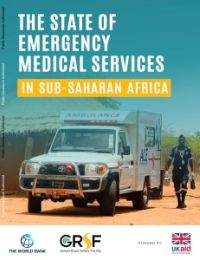
An evaluation of the various Emergency Medical Services (EMS) models and mechanisms in place in Sub-Saharan Africa (SSA) is critical in order to have a better understanding of what can be improved upon for effective pre-hospital and emergency care services (PECS). With grant funding provided by the World Bank’s Global Road Safety Facility (GRSF), this report aims explore the State of EMS Systems in Sub-Saharan Africa through a review of the models and mechanisms being developed across various States.
The premise of the report focuses on the fundamentals for effectively providing satisfactory treatment to those in need of urgent medical care, while also recognizing that there are multiple pathways, framed by the respective legislative, legal and regulatory enabling environments, towards a more formal and sustainable EMS model. It represents an effort to identify the major similarities and differences, as well as potential opportunities for greater coordination or collaboration, that can lead to the development of sound policy recommendations for fostering and expanding post-crash response services in the region.
High-level system information has been collected through questionnaires distributed to National Respondents in each country, for which 25 of 44 countries substantially responded as of April 2019 (collectively hereinafter referred to as SSA countries): Botswana, Burkina Faso, Burundi, Cabo Verde, Cameroon, Central African Republic, Chad, Comoros, Congo Brazzaville, Gabon, Lesotho, Liberia, Madagascar, Malawi, Mauritania, Niger, Rwanda, Senegal, Sierra Leone, Sudan, Tanzania, Togo, Uganda, Zambia and Zimbabwe. Missing data and discrepancies triggered a detailed review of laws and other regulatory acts, policy and plan.
The Report does not consider the advantages and disadvantages for the EMS models adopted by SSA countries, nor does it take a position on which regulatory approach should be applied, or measure the degree of EMS standards implementation and the success or failure of implementing various EMS policies. The principal aim of this report is to capture the current range of the standards and regulations in key areas of EMS systems across SSA.
The State of Emergency Medical Services in Sub-Saharan Africa is supported by UK Aid through the World Bank’s Global Road Safety Facility.

The World Bank estimates a significant funding gap in road safety of 260 billion to achieve SDG 3.6 and 11.2 in the next ten years, and recognizes that this gap cannot be closed through public funding alone and thus mobilization of private capital is required. The impacts of road traffic crashes reach far into the economy and can cost L/MICs as much as 6% of their GDP. The costs of a road traffic crash do not end at the roadside; they create ripple effects throughout the wider economy. Loss of income, property damage, insurance premiums, loss of taxes, and burdens on the health sector are just some of the far-reaching costs associated with road traffic crashes. Road traffic crashes can cost countries as much as 6 percent of their GDP and trap families in poverty as they lose income generating potential and focus on providing lifetime care.
This report examines the potential for private capital mobilization to close this gap. The report investigates the market failure to appropriately account for the cost of road crashes, which prevents private capital from flowing to road safety investments. The growth of socially responsible investing and the sustainable finance market offers a new opportunity to address this market failure. The report proposes different business models and financing instruments to channel private investment into road safety projects. These investment structures consist of subnational, public-private partnerships (PPPs) and corporate investments that can leverage the growing sustainable finance market, including social and sustainability-linked financings (SLFs).
The report also develops indicators that can be used to tie the cost of financing to the attainment of road safety targets, incentivizing borrowers to commit to road safety as part of SLFs. The report examines the enabling environment for structuring investable road safety projects in a sample of countries, looking at the barriers and opportunities, and proposing risks and mitigation strategies, like blended finance mechanisms and stable revenue sources, for long-term sustainability of road safety investments.

What is the real cost of speeding on people and the environment? These 6 graphs tell the story ⌵︎
The impacts of speed on the safety of road users, on congestion, on pollution, and on total costs of road travel are broadly misunderstood: often based on wrong assumptions, with effects taken as self-evident, failure to consider multiple impacts, externalization of costs by many stakeholders, and under-estimation of impacts (especially economic costs of higher speeds). The purpose of this brief note is to provide information on these relationships relevant to fundamental road transport policies, design, and operation. Well-established evidence shows the importance of managing travel speeds for road safety, for efficiency, for improved inclusion, and for greenhouse gas (GHG) and other emissions. Thus, speed management is a strong policy lever for the breadth of issues which must be addressed for sustainable mobility.
Reduced speeds of travel represent a major, yet under-appreciated, opportunity to improve safety, climate change impacts of travel, health, inclusion, the economy, and in some circumstances, congestion. Speed management can be achieved through a range of interventions including road infrastructure and vehicle technology, as well as enforcement and promotion.
The six graphs presented in this note tell a powerful story, across the range of these benefits of speed management.
This publication is also available in:
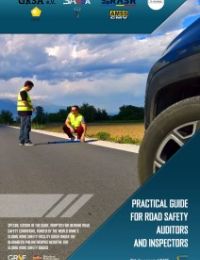
After almost two decades of experience with Road Safety Audit (RSA) Worldwide, this procedure is now recognized as one of the most efficient engineering tools. RSA is a highly efficient and cost-effective engineering tool for improvement of safety on roads. It is much cheaper to identify road safety deficiencies in the process of design than later after construction is completed. RSAs are among the most cost-effective investments a Road Authority can undertake.
With its EU Directive No. 2008/96 and amendment 2019/1936 on road infrastructure safety management, the European Union (EU) made a clear decision that RSA will be mandatory for the Trans-European Road Network (TERN) and main roads. This Directive contains another tool called Road Safety Inspection (RSI) on safety deficiencies of existing roads. The RSI is very similar to the process of Road Safety Audit in the pre-opening phase of newly constructed roads. RSIs are essential for the redesign and upgrading of existing roads, and these are done in many countries to give the designers insights and direction for safety improvements. Given that, the purpose of this practical guide is to provide practical guidance to those doing RSAs and RSIs, the examples of typical design deficiencies shown should be useful to both road safety inspectors and road safety auditors.
This document draws on the more comprehensive guidelines and manuals on Safety engineering mentioned in the acknowledgements but deliberately focuses only on these issues of direct relevance to road safety auditors/inspectors and to the road safety reports that they must prepare, including of recommendations for improvements.
This is a special edition of the guide, adapted for Ukraine road safety conditions and legislation, funded by the World Bank‘s Global Road Safety Facility (GRSF) under the Bloomberg Philanthropies Initiative for Global Road Safety (BIGRS).
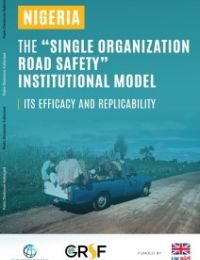
This study is one part of a comprehensive study of lead road safety agencies in low- and middle-income countries (LMICs), which is being conducted on a collaborative basis by the World Bank, the World Health Organization, and the African Development Bank. This particular study is supported by UK Aid through the World Bank’s Global Road Safety Facility (GRSF). It focuses on the case of Nigeria, a federal republic with three tiers of government - federal (central), state and local governments - and its single institutional model for road safety.
This report responds to the following questions:
Download the report to learn more!
RESOURCES ⌵︎
ACKNOWLEDGMENTS ⌵︎
‘The “Single Organization Road Safety” Institutional Model, its Efficacy and Replicability’ Study is supported by UK Aid through GRSF. The Report was written by three main authors: Martin Small, Mustapha Azzouzi and Arpita Roy. The study was led by Farhad Ahmed (Senior Transport Specialist) with support from Md. Towshikur Rahman, who was responsible for the overall coordination.
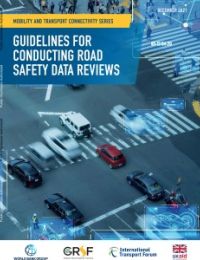
Download the document in English
Download the document in French
Download the document in Spanish
In many countries around the world, deficiencies in data or data quality impair evidence-based road safety policy making. While many countries collect road safety data, the collection is not necessarily comprehensive. Further, many countries can be unaware of data gaps in their system, which prevents them from soundly analyzing their road safety problems. Therefore, road safety data definitions and collection methods must converge into standard international criteria, thus allowing for comparisons in space - across countries - and in time.
This is the raison d’etre of regional road safety observatories, which have been developed, for example, in Latin America (OISEVI), Africa (ARSO), and Asia-Pacific (APRSO). They present an opportunity for joint regional efforts to improve, in a harmonized way, road safety data collection and analysis. Regional road safety observatories promote the adoption of a common set of road safety indicators based on common definitions and serve as an avenue to assist countries in improving the management of their crash data systems.
This document is designed to support reviewers in the assessment of road safety data collection; the complete range of safety data should be considered. This task can be complicated because collection of road safety data is often not achieved by activities dedicated to this purpose, but rather through piggybacks on other sources. For example, activity reports from police or hospitals are used to provide material for legal or medical purposes. The routines involved frequently have a long history in which gathering reliable and complete statistics has had secondary priority, at best. The various actors involved reflect the complex structure of a country’s judicial and executive system, which, generally, are not coordinated. Consequently, any review of the data collection process requires some “detective work.”

This guide has been prepared to assist a jurisdiction to determine the level of readiness to move to automated enforcement (AE). Speed cameras enforcing speed limits are a common application of AE and there are many systemic legal and operational elements that must be in place before AE can be effective. For example, an accurate image of a speeding vehicle, in the absence of robust driver licensing and vehicle registration systems, is of little road safety value. Importantly, automated speed enforcement should be considered as one part of a comprehensive speed management approach that includes road infrastructure and roadside policing as well. The management of speed is a fundamental element of the Safe System.
Aims of this document:
Other illegal behaviours, including disobeying a red light signal, mobile or cellular phone use, incorrect lane use, and non-restraint use can also be detected using an automated enforcement approach. However, this document applies specifically to automated speed enforcement, because speed management requires significant attention worldwide and plays a critical role in reducing road traffic deaths and injuries.
Document also available in French, Portuguese, Vietnamese and Spanish.
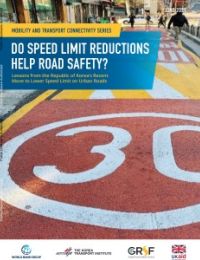
Significant research has been undertaken on how changes in speed limit—for example, the introduction of 30 kilometers per hour, or kph (20 miles per hour, or mph) speed limits—impact safety both when combined with, and without "traffic-calming" engineering treatments such as speed humps or raised platforms. However, most of the studies have been conducted in Australia or countries in Western Europe, with almost no recorded studies from Asia, Africa, the Americas, and Eastern Europe. Though it may be reasonable, a well-developed infrastructural environment such as that found in Korea would expect similar results as that of the western countries, a study originating in Asia could have a strong demonstration effect and prove very convincing for many Asian countries.
With this in mind, the main aim of this study is to present the findings from Korea’s reduced speed limits on safety performance and to support the establishment of suitable speed-management strategies based on a quantitative data-driven approach. The scope of the project was as follows:
To start, this report first provides a brief literature review on the concept of Safe System speed limits, and the effect of speed limit reductions as part of speed management in several countries, followed by a brief description of the evaluation methods for the before-after assessment. This is followed by a summary of the findings, a set of recommendations, limitations of this study, and finally, a capsule of future research that could be undertaken to either extend or follow up on the study.
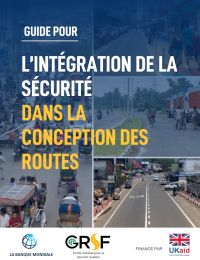
Ce guide se concentre sur les éléments des conceptions de routes et de bordures de route sûres pour les réseaux routiers qui peuvent offrir une mobilité sûre à tous les usagers de la route.
Une réduction substantielle des décès sur les routes ne sera réalisable que si des efforts concertés sont déployés, en suivant l'approche du « Système sûr » impliquant tous les éléments de la sécurité routière, de la gestion et de la prestation. Cela inclut tous les piliers du Système sûr — à commencer par la gestion de la sécurité routière, les routes et bordures de route sûres, la vitesse sûre, les véhicules sûrs, les usagers de la route sûrs et les soins post-accident. Ce guide se concentre sur les éléments des conceptions de routes et de bordures de route sûres pour les réseaux routiers qui peuvent offrir une mobilité sûre à tous les usagers de la route, ainsi que sur les changements complémentaires pour améliorer les vitesses, la sécurité des véhicules, les comportements des usagers de la route et les soins post-accident. Une conception équilibrée des routes doit prendre en compte ces éléments complémentaires du système pour maximiser les avantages en termes de sécurité. L'énergie portée par un objet en mouvement est proportionnelle au carré de sa vitesse. Une « bordure de route indulgente » bien conçue garantit que cette énergie est dispersée en cas de collision et, par conséquent, moins d'énergie est transférée aux occupants.
La conception des infrastructures routières joue un rôle vital dans les résultats en matière de sécurité routière. Des infrastructures sûres soutiennent les autres piliers de la sécurité routière en encourageant un comportement approprié des usagers de la route (comme une vitesse appropriée et une position correcte sur la voie) et en offrant un environnement routier indulgent en cas d'erreur. Une infrastructure routière mal conçue peut entraîner des comportements dangereux des usagers de la route. Une des principales réalisations de l'approche du Système sûr est que les conducteurs font des erreurs et continueront à en faire, même si nous pouvons réduire leur fréquence. Cette erreur des usagers de la route a longtemps été reconnue comme un contributeur significatif aux mauvais résultats en matière de sécurité routière. Cependant, les routes, pour une vitesse donnée, peuvent être conçues pour réduire la probabilité de collisions, et il existe des preuves très claires que la gravité des résultats lorsque des collisions se produisent est significativement influencée par la conception de la route. Même si une collision se produit encore, une infrastructure routière améliorée peut sauver de nombreuses vies et prévenir des blessures débilitantes.
L'approche du Système sûr souligne qu'une réponse partagée est nécessaire pour aborder la sécurité routière. Cela signifie que les usagers de la route continueront à assumer la responsabilité de leurs actions, par exemple en étant vigilants et en respectant les règles de la route. Cependant, il est également reconnu que les gestionnaires et les concepteurs de routes ont une responsabilité significative de fournir un système routier qui protège tous les usagers de la route. Cela peut être réalisé grâce à des conceptions appropriées des routes.

